There Are More Than Two Devils Marbles!
Devils Marbles Conservation Reserve, Australia, NT
The Devils Marbles are amongst the most famous Australian rocks, right up there with Uluru and the Olgas.
All guide books and brochures about the Australian Outback feature a picture of the Marbles. Or rather, of two of the marbles...
I wonder how many people are aware that the Devils Marbles Conservation Reserve is 1802 hectares in size, and that there are lots of marbles here.
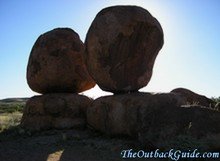 That people might think of the Marbles as just those two huge rocks had never crossed my mind. Until my friend stood there in the reserve with an open mouth and went "wow!"
That people might think of the Marbles as just those two huge rocks had never crossed my mind. Until my friend stood there in the reserve with an open mouth and went "wow!"
When she explained why she was so surprised it dawned on me... Of course! You never see anything else but that one famous picture, and there's rarely any useful information with it.
Well, there's a bit more to this area than two red rocks...
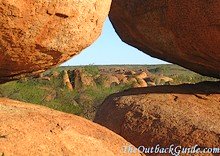
- Where are the Devils Marbles?
- What are they and how were they formed?
- The Marbles And Aboriginal Culture
- Things To Do
- Camping At The Devils Marbles
- Accommodation And Facilities Nearby
Where Are The Devils Marbles?
The Devils Marbles Conservation Reserve is located 110 km south of Tennant Creek, in the Northern Territory of Australia. Never heard of Tennant Creek?
Ok, the Devils Marbles are 393 km north of Alice Springs and 760 km south of Katherine. In other words, in the middle of nowhere.
Since the Stuart Highway between Darwin/Katherine and Alice Springs is a popular tourist drive the Devils Marbles are a popular place. There isn't much else to look at on the long drive...
On top of that the highway cuts right through the reserve. You don't have to go out of your way to see the Marbles. In fact, if all you want is that one picture then you don't even have to get out of your car...
But I hope you will get out of your car, because that's the only way to appreciate the beauty of this unusual area. More on that below.
What are the Devils Marbles and how were they formed?
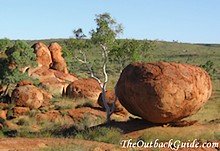
The Devils Marbles - or Karlu Karlu as they are known by the local Warumungu Aboriginals - are a collection of huge, red, rounded granite boulders.
Actually, they vary in size, from 50 cm up to six metres across, and they are strewn across a large area. Many of them seem impossibly balanced on top of each other, just like the two marbles in the famous picture.
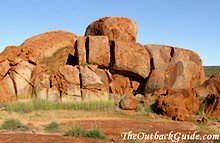
How did they end up that way? The Devils Marbles started out, many million years ago, when an upsurge of molten rock reached the surface, spread out and settled into a solid layer.
That one block of granite then developed horizontal and vertical cracks and split into many rectangular blocks.
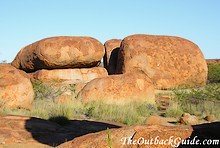
Over the following millions of years erosion did what it always does: it wore away the edges.
You can see the later stages of that process all across the reserve. Some parts still hint at the original rectangular shapes, some blocks have their corners worn of, some are totally rounded.
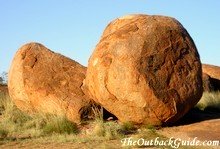
Every marble looks different. You can walk around for ages and find new and interesting views.
The piles of granite boulders offer a variety of habitats for flora and fauna. There are exposed sunny areas, shady sides, dark and moist shelters, essentially you have a range of mini refuges for sensitive plants and animals.
Native rock figs survive here. Also have a look for clusters of the bottle-shaped Fairy Martin nests under overhanging boulders, or see if you can spot a Pygmy Spiny-tailed goanna...
The Devils Marbles and Aboriginal Culture
In the Aboriginal mythology the Devils Marbles are the eggs of the rainbow serpent, and many "dreamtime" stories and traditions of the Warumungu, Kaytetye and Alyawarre Aboriginal people are linked with this area. It has a deep spiritual meaning for both men and women (Aboriginal cultural sites are often specifically for either men or women.)
The traditional Aboriginal owners of the area regard the marbles as having extraordinary powers. Damage to them can have life threatening consequences for their custodians.
Imagine their distress when in 1953 an eight tonne rock was taken from the area to be placed on John Flynn's grave in Alice Springs (the founder of the Royal Flying Doctor service).
A similar thing happened in 1980, when a rock from the Devils Pebbles (a similar area north of Tennant Creek), was removed without consulting the traditional owners.
The pebble was returned in 1981, but only after 15 months of painful controversy and the tragic death of an Aboriginal elder.
The marble from Flynn's grave was eventually returned, too, and replaced with another rock, identified by and taken with the permission of the Alice Springs Arrernte people. But it took until 1998 for that to happen...
Even today very few white Australian people understand the distress that the desecration of sacred sites can cause...
What to do at the Devils Marbles
I already mentioned that the Stuart Highway cuts through the Devils Marbles Conservation Reserve. The marbles are scattered through the valley on both side of the highway. It's the eastern side that has the walks and facilities. A short access road runs parallel to the highway for several hundred metres on that side.

Say you come from the north and turn into the reserve. You will see the most famous two marbles pretty much straight away on your left hand side. There's a small parking bay, big enough for a coach to pull up so the passengers can get out and take their photo without any danger of getting exercise.
If you follow the road you soon get to another parking bay that has a small shelter and information signs. A short self guided walk starts at that shelter. The signs along it explain the formation and the Aboriginal mythology of the area. Probably a good place to start.
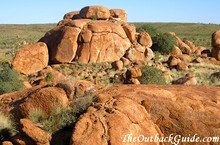
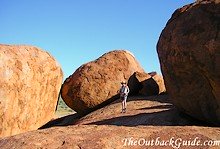
Most people seem to have a lot more fun on the other side of the road, though.
There are no official walks, just a network of informal tracks, left by the thousands of tourist that explore the area every year.
Most of the big piles are fairly easy to climb, and you really have to get right amongst them to appreciate their size.
The further you go, the more impressive the area becomes.
If you want really spectacular photos and see the Devils Marbles at their best you have to be here for sunset.
I remember seeing them many years ago during the day, and I thought, "nice". Daylight drains all the colour out of rocks, and flattens the shapes. Plus, it was stinking hot and we couldn't be bothered to do much walking and climbing.
This year was very different, because we camped here, and it was simply fantastic.
Camping at the Devils Marbles
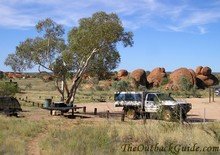
The campground is just a simple bush camping site with no facilities other than toilets, picnic tables and wood barbecues.
You have to bring your own fire wood. The camping fee is $3.30 pp and is paid on an honour system using envelopes.
The location is perfect.
To drive to the campground keep following the access road to the southern end of the reserve. A road leads around the bottom end to the back of the biggest piles of marbles, and the campground is right beneath them.
You can also have a look at the campground by following the informal tracks I mentioned before. It's not that far. And if you climb onto one of the big piles at the back you get a beautiful view over the campground and the whole valley.
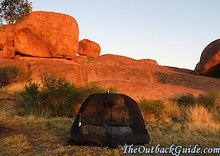
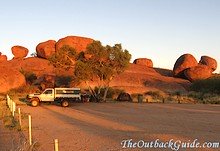
Since the campground is on the eastern side you can watch the Devils Marbles glow in the early morning sun from your pillow.
(At least I could, I have no tent, just a mozzie dome.)
It really is a very special area, and it feels very different on that side, away from the road and the tour buses, during the very last or very first daylight, when the animals are most active...
A word of warning: I was here in April. This campground would get extremely busy during the tourist season, especially between June and August.
Facilities near the Devils Marbles
The nearest settlement is Wauchope, 9km south of the Devils Marbles. You can get accommodation and food here.
If they are still around you can also meet "Jesus!", the pet camel, and "Christ!", his/her best friend, a donkey. The two are inseparable, and especially the camel is known to be very friendly. Keep your windows closed if you're not to keen on overly friendly camels.
(Update: Unfortunately the camel is now dead. Killed by a caravanner travelling just after sunset.)
Tennant Creek is 110 km to the north of the Devils Marbles, and offers everything that you'd expect from a small Outback town (accommodation, supermarkets, mechanical repairs, Aboriginal art galleries etc.), including a Visitor Centre and tours to the Devils Marbles.
These are day tours to the Marbles and include a barbecued lunch. (Definitely nothing like the sunrise and sunset views, but in a way that's good. Means we bushcampers have the place to ourselves when it's at its best...)
Return to Outback Australia Travel Guide home page





